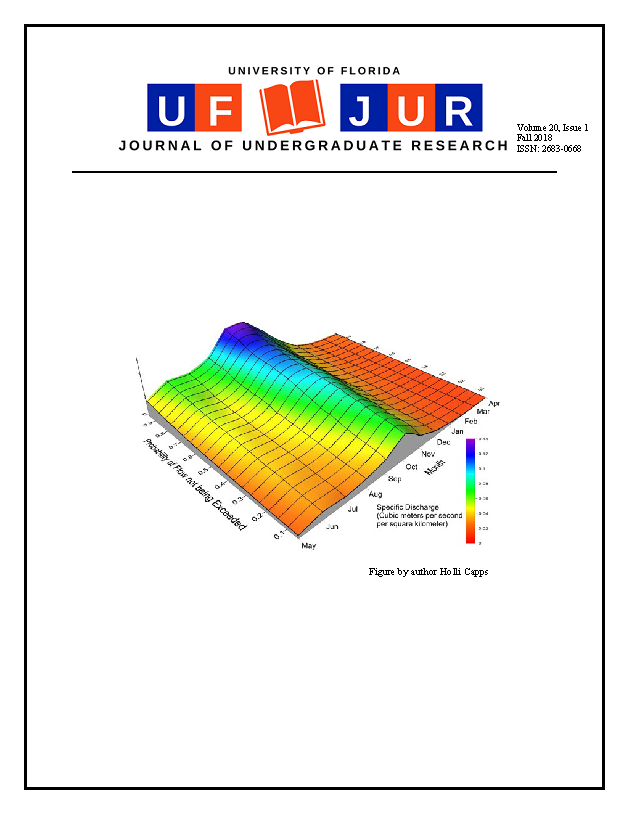Single Grain (U-Th)/He Ages from EET14074, an Acapulcoite Meteorite
DOI:
https://doi.org/10.32473/ufjur.v20i1.106303Keywords:
undergraduate research, meteorites, geological sciences,Abstract
EET14074 is a member of the acapulcoite-lodranite family of meteorites and was discovered in Antarctica in 2014 by the Korean Polar Research Institute (KOPRI). Herein, we obtained (U-Th)/He ages from 20 phosphate aggregates in EET14074 to constrain the sample’s thermal history. The ages range between 116.8 Ma ± 145.7 Ma (1σ) and 4211.5 Ma ± 1089.1 Ma, with an average of 2530 ± 260 Ma (n=20). Excluding outlier ages with large uncertainties, the 13 most concentrated ages yielded a theoretical minimum age of 3000 ± 150 Ma. This age corresponds to a fraction helium loss (f) of ~31% assuming crystallization age of ~4.55 Ga. The uranium abundances in single aliquots are in the range of 1.52 - 289.93 fmol, with an average of 58.00 fmol (n = 20), whereas the thorium abundance ranges between 2.51 and 2337.06 fmol with an average of 1149.29 fmol (n = 20). To explain the observed He loss, thermal diffusion modeling was performed with an assumption that the He loss occurred during a recent passage of the meteorite in Earth’s atmosphere. For the most likely t-T condition of compressional heating in Earth’s atmosphere of this meteorite (T = ~430 ˚C, t = ~10 sec), a fractional loss of 29.3% was calculated when the diffusion domain radius (r) of 92.8 µm was assumed. This estimation is nearly indistinguishable from the observed fractional loss of 31.3%. Additionally, diffusion modeling for another set of data with a different size (r = 40.4 µm) yielded a very similar fractional loss. Therefore, the observed (U-Th)/He age distribution is likely derived from compressional heating during the passage of EET14074 in Earth’s atmosphere.
Metrics
References
. Chang, J., & Qiu, N. (2012). Closure temperature of (U-Th)/He system in apatite obtained from natural drillhole samples in the Tarim basin and its geological significance. Chinese Science Bulletin, 57(26), 3482-3490.
. Ehlers K. and Powell R., 1994. An empirical modification of Dodson's equation for closure temperature in binary systems. Geochimica et Cosmochimica Acta 58, 241-248.
. P.W. Reiners. (U-Th)/He Chronometry Experiences a renaissance, EOS (2002)
. E. Anders, Meteorites and the early solar system, Annu. Rev. Astron. Astrophys. 9 (1971) 1-34.
. D.S. McKay, E.K. Gibson Jr., K.L. Thomas-Keprta, H. Vali, C.S. Romanek, S.J. Clemett, X.D.F. Chillier, C.R. Maechling, R.N. Zare, Search for past life on Mars: Possible relic biogenic activity in Martian meteorite ALH84001, Science 273 (1996) 924-930.
. T.J. McCoy, K. Keil, R.N. Clayton, T.K. Mayeda, D.D. Bogard, D.H. Garrison, G.R. Huss, I.D. Hutcheon, R. Wieler, A petrologic, chemical, and isotopic study of Monument Draw and comparison with other acapulcoites: Evidence for formation by incipient partial melting, Geochimica Cosmochimica Acta 60 (1996) 2681-2708.
. Min, Kyoungwon, et al. “Single grain (U–Th)/He ages from phosphates in Acapulco meteorite and implications for thermal history.” Earth and Planetary Science Letters, vol. 209, no. 3-4, (2003) 323–336.
. Reiners, P.W. and Nicolescu, S. (2006), Measurement of parent nuclides for (U-Th)/He chronometry by solution sector ICP-MS, ARHDL Report 1, http://www.geo.arizona.edu/~reiners/arhdl/arhdl.htm
Daniel Sheikh (Research assistant) in discussion, April 2018
Farley, K., Wolf, R., & Silver, L. (1996). The effects of long alpha-stopping distances on (U-Th)/He ages. Geochimica Et Cosmochimica Acta, 60(21), 4223-4229. doi:10.1016/s0016-7037(96)00193-7
Downloads
Published
Issue
Section
License
Some journals stipulate that submitted articles cannot be under consideration for publication or published in another journal. The student-author and mentor have the option of determining which journal the paper will be submitted to first. UF JUR accepts papers that have been published in other journals or might be published in the future. It is the responsibility of the student-author and mentor to determine whether another journal will accept a paper that has been published in UF JUR.

